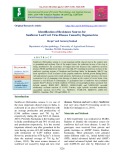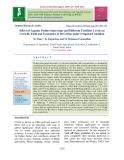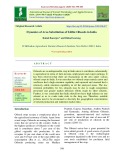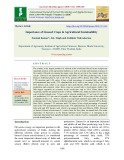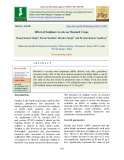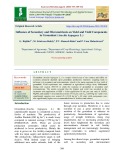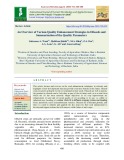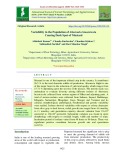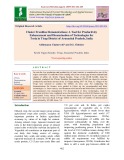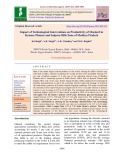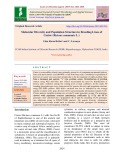
Edible oilseeds
-
This study aimed to identify the effects of safflower genotypes for individual and combined effects of PEG 6000 and NaCl stress imposed at early seed germination stages, determine correlation coefficients among traits of safflower genotypes under stress treatments, and interpret the interrelationship of treatments × safflower genotypes interaction by principal component analysis.
 12p
12p  lyhuyenthu
lyhuyenthu
 31-01-2023
31-01-2023
 9
9
 2
2
 Download
Download
-
Sunflower (Helianthus annuus L.) is an important edible oilseed crop in the country next to groundnut and soybean. One of the major factors for reduction in area of the crop is being attributed to the occurrence of fungal and viral diseases like sunflower necrosis disease (SND) and Sunflower leaf curl virus (SuLCV) resulting in yield loss in most of the sunflower growing regions of Southern and Northern India. In Karnataka, SuLCV has been reported to occur in almost all the popular sunflower hybrids grown during kharif, rabi and summer seasons with varied intensity.
 5p
5p  cothumenhmong9
cothumenhmong9
 04-01-2021
04-01-2021
 9
9
 1
1
 Download
Download
-
Sunflower is one of the four most important oilseed crops grown worldwide and the nutritional quality of its edible oil ranks among the best vegetable oils in cultivation. Sunflower oil has been traditionally appreciated in the world oil market. However, new emerging markets are demanding changes in oil quality for both food and non-food applications. Nutritional and functional properties determining oil quality are primarily determined by the fatty acid composition of oil. Seed oil content and composition are determined by genotypic factors and environmental conditions.
 14p
14p  nguathienthan8
nguathienthan8
 20-10-2020
20-10-2020
 14
14
 2
2
 Download
Download
-
Cotton (Gossypium hirsutum L.) is the most important cash crop and there is a demand for simultaneous increase in the productivity of cotton, edible oilseeds and fodders to fulfil the diversified needs of growing population. For this purpose, cotton-based intercropping seems to be a promising strategy. Short duration legume fodders are potential sources of nutrients during summer especially atmospheric nitrogen fixing which are supplement of inorganic fertilizers.
 6p
6p  nguaconbaynhay8
nguaconbaynhay8
 13-10-2020
13-10-2020
 17
17
 1
1
 Download
Download
-
Mustard (Brassica spp.), family cruciferae are the major oilseed crop grow throughout India for edible oil. It is an open pollinated crop and honeybees are effective pollinators for open pollinated crops because of a lot of nectar and pollens are available on the flowers of mustard. The studies were conducted during rabi 2013-14 and 2014-15 at ARS, Kota to enhance the yield of mustard through honey bee pollinator. Mustard variety “Bio-902” was grown following all recommended agronomic practices without spraying through the crop season.
 4p
4p  chauchaungayxua8
chauchaungayxua8
 03-10-2020
03-10-2020
 8
8
 2
2
 Download
Download
-
This paper, we make use of some concepts of Markov Chain to analyze the dynamics of area substitution of Oilseeds in different states of Indiaby estimating the probability of retention and substitution.
 6p
6p  nguaconbaynhay7
nguaconbaynhay7
 15-08-2020
15-08-2020
 11
11
 1
1
 Download
Download
-
The country is the largest producer of oilseeds in the world and oilseed sector occupies an important position in the agricultural industry as well as in trade and national economy of the country. Oilseeds are among the major crops that are grown in the country apart from cereals. Linseed is an important industrial and edible oil and fiber producing crop.
 10p
10p  quenchua6
quenchua6
 15-06-2020
15-06-2020
 13
13
 2
2
 Download
Download
-
Mustard is second most important edible oilseed crop after groundnut, accounts nearly 30% of the total oilseeds produced in India. India is one of the largest rapeseed-mustard growing countries in the world, occupying the first rank in area and second in production next to China. Total area under rapeseed and mustard in India is 5.92 million hectares with a production of 6.78 million tonnes and productivity of 1145 kg ha-1 .
 10p
10p  nguathienthan5
nguathienthan5
 04-06-2020
04-06-2020
 13
13
 1
1
 Download
Download
-
Groundnut (Arachis hypogaea L.) is a major oilseed crop of our country and edible oil economy primarily depends upon groundnut production. Intensive cropping leads to deficiency of secondary and micronutrients, which is the main constraint for low yield of groundnut. Field experiment was conducted at agricultural college farm, Mahanandi during rabi season, 2015-16 to study the response of groundnut to secondary and micronutrients.
 8p
8p  trinhthamhodang1213
trinhthamhodang1213
 29-05-2020
29-05-2020
 10
10
 0
0
 Download
Download
-
Rapeseed (Brassica napus L.) is an important oilseed crop throughout the world, serving as source for edible oil and renewable energy. Development of nested association mapping (NAM) population and methods is of importance for quantitative trait locus (QTL) mapping in rapeseed.
 17p
17p  vihashirama2711
vihashirama2711
 21-05-2020
21-05-2020
 10
10
 1
1
 Download
Download
-
This article focuses and reviews on the seed enhancement techniques in oilseeds, and highlights of new developments that may provide even more benefits in the future. Oilseed crops are grown primarily for the oil contained in their seeds. Oilseeds are rich in protein, the proteins in oilseeds can be fed either as part of the oil-intact seed, or as a meal from which the oil has been removed. Major objectives in oil crop improvement are enhancement of seed and oil yield, quality of oil according to its use, i.e.
 9p
9p  quenchua4
quenchua4
 06-04-2020
06-04-2020
 23
23
 1
1
 Download
Download
-
Mustard is one of the important oilseed crop in the country. It contributes 26.5 % to the total domestic edible oil production. Alternaria blight is one of the major factor in the reduction of yield and quality which ranges from 15-71 % depending upon the severity of the disease. The present study was undertaken to evaluate diversity among different isolates of Alternaria brassicicola collected from various regions of Bihar and adjoining parts.
 9p
9p  chauchaungayxua4
chauchaungayxua4
 18-03-2020
18-03-2020
 19
19
 0
0
 Download
Download
-
Indian mustard (Brassica juncea) is the second most important edible oilseed crop in the country after soybean. Mustard is an important source of healthy edible oil in the northern states of the country viz., Uttar Pradesh, Rajasthan, Uttarakhand, Haryana, Punjab and Bihar. The production of edible oil in the country is lagging behind the growing demand by ever increasing population and therefore increasing its import. Preventing the loss by various biotic and abiotic stresses is one of the ways to increase the production of mustard oil.
 6p
6p  trinhthamhodang3
trinhthamhodang3
 14-02-2020
14-02-2020
 8
8
 1
1
 Download
Download
-
Groundnut (Arachis hypogaea L.) is an important edible leguminous oilseed crop. Diseases of groundnut act as the limiting factor to its economic production. Recently, the stem rot caused by Sclerotium rolfsii is becoming severe disease of groundnut in India. Crop Losses up to 59 per cent due to stem rot disease have been reported by many researchers.
 6p
6p  nguaconbaynhay3
nguaconbaynhay3
 07-02-2020
07-02-2020
 16
16
 1
1
 Download
Download
-
In toria the low production and productivity of local varieties is considered as one of the major constraints of traditional toria farming which has created gap between demand and supply of edible oil. Krishi Vigyan Kendra- Tirap of the ICAR-ATARI, Zone-VI, Guwahati conducted the Cluster Frontline Demonstration (CFLD) on oilseed to increase productivity and farmer income in the 12 villages during 2017- 18. Thus, 12 villages of the Tirap were selected to conduct the CFLDs on toria crop.
 4p
4p  quenchua2
quenchua2
 18-12-2019
18-12-2019
 7
7
 1
1
 Download
Download
-
India is the fourth largest oilseed producer in the world. Among the edible oilseed crops cultivated in India, mustard occupying the second position after groundnut sharing 27.5 per cent in Indian economy. It is also one of the important oilseed crops of Madhya Pradesh and is commonly grown in Sidhi district which falls in Kymore Plateau and Satpura Hills zone of the state. Krishi Vigyan Kendra, Sidhi conducted 64 technological frontline demonstrations to know the yield gap between improved package of practices (IP) and farmers practices (FP) under limited irrigation conditions.
 8p
8p  cothumenhmong1
cothumenhmong1
 11-12-2019
11-12-2019
 16
16
 0
0
 Download
Download
-
Castor is a non-edible oilseed crop, primarily grown for oil containing an unusual hydroxy fatty acid and ricinoleic acid (80–90%) of the total fatty acids. Commercial exploitation of heterosis in castor was successful in India due to the development of stable pistillate lines from a dominant and epistatic “S” type pistillate source. Diversification of pistillate sources using NES and other new sources necessitated the need for identification of diverse male combiners among the existing pool of male combiners.
 15p
15p  cothumenhmong1
cothumenhmong1
 08-12-2019
08-12-2019
 13
13
 0
0
 Download
Download
CHỦ ĐỀ BẠN MUỐN TÌM










